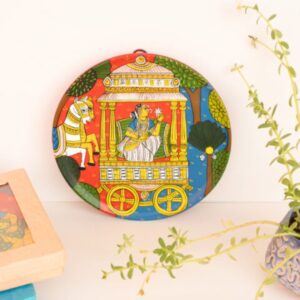Sai Kiran Dhanalakota had nearly decided that he would study animation. No matter that his family’s profession was traditionally the Nakashi art form, a stylized form of which is Cherial art. No matter that his grandfather D Chandraiah and father D. Nageshwar were both award winners for this art. No matter that he had helped his family with the art since he was in primary school.

Sai Kiran Dhanalakota and his art
Little did he know that a chance meeting with Ms. Vani Devi, principal of the Sri Venkateswara College of Fine Arts, would change his life completely. She offered him a free seat in the college and the five years taught Sai Kiran a lot of things. Primarily, it strengthened his resolve to put Cherial art on the Indian crafts map.

Getting ready for making Cherial masks
Sai Kiran and his family have kept the traditional art form, mixing colours per tradition: red from inglikam stones, blue from indigo, and black from lamp soot, for instance.
But innovations abound. Sai Kiran and his family soon ventured into other products: spectacle cases, keychains, T-shirts, etc. The art form, which told a story, was now captured in a single frame.
Cherial art also adorns the 163-foot kitchen tunnel at the Rashtrapati Nilayam in Hyderabad. For a project, Sai Kiran worked with the 100 Pipers “The Legacy Project” which featured his work, along with five other traditional artists, on the brand’s canisters, on the theme of what goodness meant to them.
When Club Artizen approached Sai Kiran, we found a partner willing to experiment with form and function. Our first product with them was a pair of coasters: one with a traditional motif of a lady with a lamp, and another, that of a woman playing a guitar!
The next product brought out the innovative nature of our work: using recycled CDs, the Cherial master artist created tealight holders for Diwali!
For each product, the Dhanalakotas use the traditional method of creation:
Tamarind seeds are crushed and the powder is boiled to make a paste, which is combined with chalk, and tirumani gum, and applied to khadi cloth. After two coats, an outline is drawn and the customary red is filled in, before other designs and colours are. Masks are made this way and paintings follow a slightly different method, even as the techniques are all still traditional.
We look forward to many more such products bringing together sustainability, recycling, and Cherial art!
Products in Cherial art






